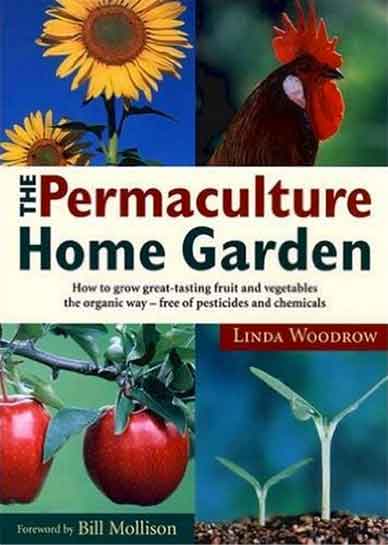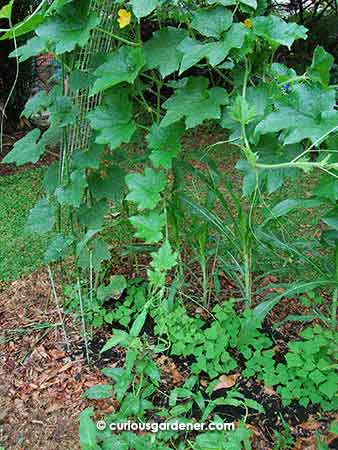The term “permaculture” is a mash-up of the words “permanent” and “agriculture” or just “culture”. It was first conceptualised in the 1970s by Australian, Bill Mollison and his student David Holmgren.
As you may or may not know, one of my initial experiences with permaculture was reading the book “The Permaculture Home Garden” by Linda Woodrow. It’s a useful and inspirational book that lives up to its title – as in it explains how you can implement permaculture practices in your garden. The only issue was, like many books, it was written based on a different area of the world, and many of the plants were unfamiliar to me, except in name. However, it fired up my imagination and I wanted to learn more.
So I continued in my search to understand this intriguing concept. Along the way, I realised that there were many interpretations of it – in extreme cases, going back to nature and living in hippie communities or living as off the grid as possible in rural settings. That’s become a pretty stereotypical perception of permaculture.
Then there are more “intellectual” permaculturists, who like to know how everything works and are more inclined towards engineering things like aquaponics or hydroponics, or constructing wicking or self-watering beds. They may also be very concerned about details like soil composition, how to compost and all kinds of scientific nitty-gritty things.
To make it more confusing, people who use back-to-nature methods like using woodchips in the Back to Eden method, or companion planting refer to these as “permaculture”.
The thing is, permaculture is so wide-ranging that it could be any of the above. Just as in religion, splinter groups abound when people choose to use the parts that they like, can use or that make sense to them, but still use the overall term to describe what they’re doing. So I got pretty confused and lost along the way.
Well, the best thing to do in situations like this is to get down to the basics, and this meant learning more about Bill Mollison, who started it all. Sadly, Mollison passed away just a couple of months ago, leaving the permaculture world in mourning at the loss of the “Father of Permaculture”. However, there is a lot of information to be found online, and I found many videos of him teaching, visiting other countries and lots more. I think I will catching up on these for a while!
What I did learn was that Mollison created the three ethical principles of permaculture: care of the earth; care of people; and return of surplus to Earth and people. He came up with these because he saw things changing for the worse around him and knew that not taking action would have devastating results on the environment, our food production, and our survival in the long run. He also felt that doing things like conducting rallies and protests wouldn’t be effective fast enough, so he took a page from Ghandi’s book and decided to be the change he wanted to see – he began the permaculture movement to change peoples’ minds and to work with nature. And if we go by how nature works – weeds grow like crazy because they are plants that have found the most suitable conditions for them to grow, but being plants we had not planned for, are unwanted by us. However, this just shows that putting the right plants in the right conditions will allow them to grow well.
And this is what permaculture seeks to do – work with nature to create abundance. It may not look pretty if you’re going for the food forest approach, but it sure can yield a lot of fruits and vegetables!
I’m still working on making the bits and pieces come into focus, but I respect the idea of working with nature and I feel we need to change the way we approach growing edible food, especially commercially. We should be more careful of how we treat our planet, because we have to keep living on it. Anyway, I’ve already tried doing things the neat and controlled way, only to find that plants grow however they wish to. And about a year of iffy health and insufficient time has let the garden grow pretty wild, so you could say I’ve gone from one extreme to the other. Rather than fight with the plants, I want to work with them. So, perhaps permaculture is the thing for me.
With that in mind, I’ll be doing a permaculture design course. After all, my dad always said that if you’re going to do something, do it properly. In this case, it’s learning from the right teachers. I’ll just say that 2017 is going to be an interesting year as our garden will likely go through some interesting changes. My ultimate dream is to have a food producing garden that is also a habitat for local fauna and beneficial critters.
Does that sound too idealistic to you? Here, take a look at this video on Britain’s oldest forest garden:
These are the books mentioned in the video:
“The Permaculture Garden” by Graham Bell
“The Permaculture Way: Practical Steps to Create a Self-Sustaining World” by Graham Bell
Or if you really want to get serious, just get the permaculture “bible”, “Permaculture: A Designers’ Manual” by Bill Mollison. Note that this one is not for the faint of heart – it’s a textbook!
You can also take a look at this free resource from Geoff Lawton called The Permaculture Circle, where you will find a selection of videos and more to whet your appetite.
A dream doesn’t have to remain a dream – even if we can’t fulfil the entire vision, there are still parts that can be achieved. I think it’s worth trying, especially when it’s good for nature and the environment.
© 2016 curiousgardener.com All rights reserved.


